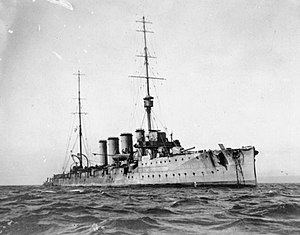Name HMS Glasgow Laid down 25 March 1909 Construction started 25 March 1909 Length 138 m | Namesake Glasgow Completed September 1910 Launched 30 September 1909 Beam 14 m | |
 | ||
Fate Sold for scrap, 29 April 1927 Class and type Town-class light cruiser Builder Fairfield Shipbuilding and Engineering Company | ||
Hms glasgow 1909
HMS Glasgow, the sixth ship of that name, was a Town-class light cruiser built for the Royal Navy in the first decade of the 20th century.
Contents
Design and description
The Bristol sub-class was rated as second-class cruisers suitable for a variety of roles including both trade protection and duties with the fleet. They were 453 feet (138.1 m) long overall, with a beam of 47 feet (14.3 m) and a draught of 15 feet 6 inches (4.7 m). Displacement was 4,800 long tons (4,900 t) normal and 5,300 long tons (5,400 t) at full load. Twelve Yarrow boilers fed Glasgow's Parsons steam turbines, driving four propeller shafts, that were rated at 22,000 shaft horsepower (16,000 kW) for a design speed of 25 knots (46 km/h; 29 mph). The ship reached 25.85 knots (47.87 km/h; 29.75 mph) during her sea trials from 22,406 shp (16,708 kW). The boilers used both fuel oil and coal, with 1,353 long tons (1,375 t) of coal and 256 long tons (260 t) tons of oil carried, which gave a range of 5,830 nautical miles (10,800 km; 6,710 mi) at 10 knots (19 km/h; 12 mph).
The main armament of the Bristol class was two BL 6-inch (152 mm) Mk XI guns that were mounted on the centreline fore and aft of the superstructure and ten BL 4-inch Mk VII guns in waist mountings. All these guns were fitted with gun shields. Four Vickers 3-pounder (47 mm) saluting guns were fitted, while two submerged 18-inch (450 mm) torpedo tubes were fitted. This armament was considered too light for ships of this size, while the waist guns were subject to immersion in a high sea, making them difficult to work.
The Bristols were considered protected cruisers, with an armoured deck providing protection for the ships' vitals. The armoured deck was 2 inches (51 mm) thick over the magazines and machinery, 1 inch (25 mm) over the steering gear and 0.75 inches (19 mm) elsewhere. The conning tower was protected by 6 inches (150 mm) of armour, with the gun shields having 3-inch (76 mm) armour, as did the ammunition hoists. As the protective deck was at waterline, the ships were given a large metacentric height so that they would remain stable in the event of flooding above the armoured deck. This, however, resulted in the ships rolling badly making them poor gun platforms. One problem with the armour of the Bristols which was shared with the other Town-class ships was the sizable gap between the bottom of the gun shields and the deck, which allowed shell splinters to pass through the gap, giving large numbers of leg injuries in the ships' gun crews.
Service history
On the outbreak of the First World War, she was operating off the coast of South America under Captain John Luce, and on 16 August 1914 she captured the German merchant ship SS Santa Catherina. In the South Atlantic on 1 November 1914, she saw action at the Battle of Coronel, when, together with the cruisers HMS Good Hope and HMS Monmouth, she engaged the German East Asia Cruiser Squadron, including the new cruisers Scharnhorst and Gneisenau. Having inflicted little damage on the enemy, Glasgow escaped with moderate damage considering that an estimated 600 shells were fired at her, although the other British cruisers were lost with all hands. Next month, in the battle of the Falkland Islands, in company with the battlecruisers HMS Invincible and HMS Inflexible, the battle with Admiral Von Spee was resumed on more advantageous terms. The victory was convincing with HMS Glasgow helping sink Leipzig. Another German ship, Dresden, escaped this particular battle, only to be later found by the Glasgow and HMS Kent and forced to scuttle after a short battle near Mas a Tierra. After the sinking a sailor from Glasgow noticed a pig swimming in the water and after nearly being drowned by the frightened pig, succeeded in rescuing him. The crew named him 'Tirpitz', and he served as the mascot of HMS Glasgow for a year and was then transferred to Whale Island Gunnery School, Portsmouth for the rest of his career.
Glasgow was assigned to operate in the Mediterranean in 1915, and in 1917 was reassigned to the 8th Light Cruiser Squadron in the Adriatic Sea. In early 1917, Glasgow accompanied HMS Amethyst in patrolling the Brazilian coast for German raiders, such as SMS Möwe.
After the war Glasgow served briefly as a stokers' training ship before being paid off in 1922 and sold for scrapping on 29 April 1927 to Thos W Ward, of Morecambe.
Mt. Glasgow in the Canadian Rockies in Alberta, Canada is named after this ship.
In 1964 she was pictured in error on a Falkland Islands commemorative stamp, see HMS Glasgow error.
